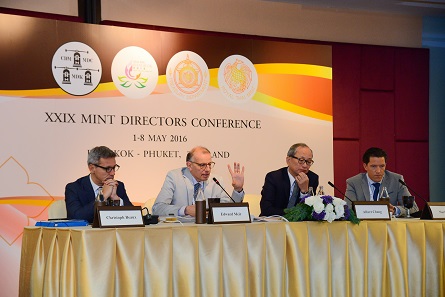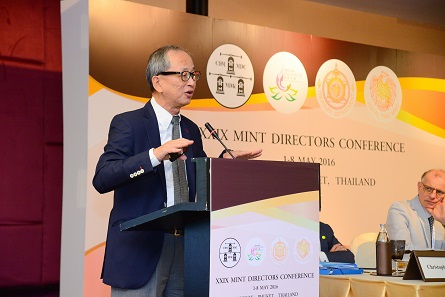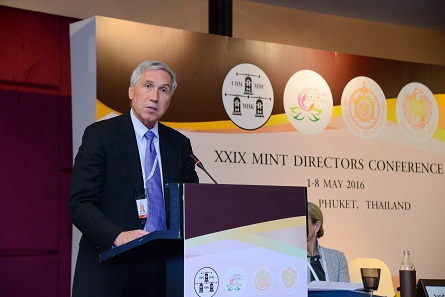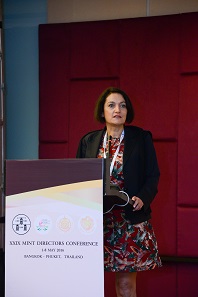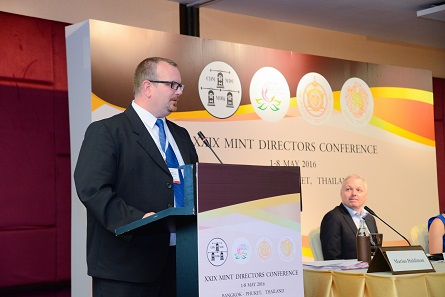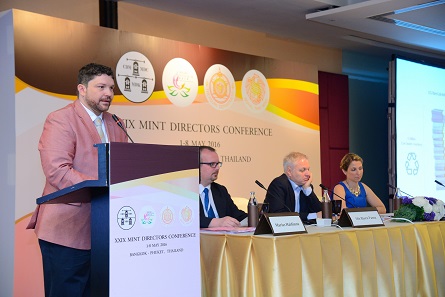by Ursula Kampmann
translated by Annika Backe
July 7, 2016 – From May 1 to 4, 2016, the Mint Directors Conference took place in Bangkok. It was attended by nearly 360 delegates for whom 35 presentations were held. Here you find an abstract of the papers given by the Marketing Committee.
Bullion markets, present and future
For many mints, bullion coins are an important field of business. The price of gold and the accompanying demand among customers, therefore, is a riddle that needs to be answered to facilitate the planning of future editions. Christoph Beaux of Monnaie de Paris chaired the session.
The attendees of the session, from left to right: Christoph Beaux, Edward Meir, Albert Cheng, and Mark Valek. Photograph: Mint of Thailand.
Three speakers dealt with this issue: Edward Meir, an independent consultant who analyzes price trends of metals in behalf of FC Stone, Albert Cheng, member of the World Gold Council, and Mark Valek, staff member of the asset-manager Incrementum.
Edward Meir and Albert Cheng agreed on one thing: The gold market of the East, including India and China, is much more important than the gold markets of the West. The development of the gold price thus depends primarily on how these two markets behave. Considerably more important than the investor sector is the jewelry industry, whereas demand remains stable in the technical sector. Both speakers found it quite remarkable that the central banks have resumed buying gold as security.
Albert Cheng of the World Gold Council focused on current trends of the gold market. Photograph: Mint of Thailand.
Of course, nobody can say for sure how the gold price will develop for there are too many aspects involved that are unable to be influenced. Edward Meir provided a description: While the moderate inflation is not really likely to affect the price, geopolitical crises may well accelerate the run on gold as a safe haven. Rising real interest rates and stocks, on the other hand, are likely to become bearish factors for the gold price.
Mark Valek of Incrementum, in contrast, is convinced that the gold price will rise when inflation increases. And because our current fiat money system needs a continuing inflation in order to function, it is the one who invests in gold who will turn out the winner in the long run.
The Incrementum AG report on the forecast of the gold price, published on June 28, 2016, can be found here.
Jon Cameron of the U.S. Mint introduced the excellent U.S. Mint’s program for children and youths. Photograph: Mint of Thailand.
The marketing of numismatics
Three market leaders – the U.S. Mint, the Austrian Mint, and the Royal Australian Mint – presented their ideas as to how the mints’ programs of commemorative coins could be made attractive to an even larger group of buyers. Sandra Hanington, new Mintmaster of the Royal Canadian Mint, presided over the session.
Jon Cameron talked about the truly unique material the U.S. Mint makes accessible for children and schools on the internet free of charge. To date, 450 fully prepared lessons are digitally available.
Here you can find the ‘Learn’ sector of the U.S. Mint.
This part is addressed to the teachers.
Part of the Kid’s Collectors Club is a site tailored to the needs of children.
Andrea Lang of the Austrian Mint introduced her approach to customer loyalty. Photograph: Mint of Thailand.
Andrea Lang of the Austrian Mint addressed the question of how a historic brand may be buffed up. She expressed her concern about the fact that the customers of numismatic products are getting older and older.
The Austrian Mint is responding to this by attempting to accompany the customers on their way through life. There are products for christenings, weddings and other important events in life that are being offered at precisely the right time through direct marketing. In addition, the Austrian Mint builds on TV commercials and aims at a customer-centric culture. A part of the product portfolio is closely aligned with the lifestyle of the targeted audience.
Mark Cartwright of the Royal Australian Mint also focused on how to win not just collectors as customers. He deemed it vital to stay nimble in order to react to market shifts without delay. It would be important to listen carefully to the customer and develop a meaningful relationship. Through telling real good stories a sentimental connection to both the product and the mint could be created.
Marius Haldimann of the Swissmint was the chair of the third session of the Marketing Committee that revolved around customer needs. Photograph: Mint of Thailand.
Marketing: The markets, bullion, and numismatics
Chaired by Marius Haldimann, the third session focused on the customer and on how not only to win him but to keep him.
For starters, Ola Bjorn Fausa of Samlerhuset talked about approaches to expand the customer base. He pointed out that the market for Classical numismatics is experiencing a boom whereas it is increasingly difficult to market new commemorative coins. He said that this was due to the fact that mints are doing far too little to acquire new groups of buyers. His idea was to allocate at least 5% of sales for the acquisition of new customers which can then, through direct marketing, become regular customers. It would be essential to reach the customers via different channels, meaningfully combining print media and internet.
The next speaker was Danielle Oliari of CNT Inc. who raised the question of how a company which a customer can only grasp through a site on the internet can gain the customer’s trust. Her main conclusion was a finding that the traditional coin trade observes for centuries: The goal is no short-term sale but a long-term relationship. The sale must come with the offer to re-buy to make the investor and his heirs feel that they have invested in the right medium.
Charles Morgan presented his calculation that the Krause-Mishler of the 21st century will span 11,000 pages. Photograph: Mint of Thailand.
The session was concluded by Charles Morgan and his outright warning to all mints to not produce too many coins. He referred to an impressive example in order to illustrate the great increase in coins struck: While the Krause-Mishler spans only 1,344 pages for the 20th century, at this pace of new issues it will rise to 11,000 pages in the 21st century! Charles Morgan emphasized that the coin customers were no end-consumers; rather, they would feed their coins into the secondary market eventually. If they realized that the value of their commemorative issues only amounted to a fraction of what they had paid for it in the first place, they would lose trust in the issuing mints.
General considerations in regards to official coin releases
How does Monnaie de Paris deal with altered and modified coins, asked Rémy Baillet of Monnaie de Paris. The question resulted from the fact that an increasing number of official coins are being ‘ennobled’ by private firms through the application of ink or partial gilding in order to obtain a higher price. While the dealers claim the pieces to have been rendered unique, they have in fact lost their status as legal tender. Furthermore, this business model does not acknowledge the intellectual rights of mints and designers. Although it is private companies that make such alterations, the customer links the product with the mint. Because Monnaie de Paris is not the only one facing this problem, the MDC set up a taskforce.
It developed a multi-step procedure:
- Weekly searches of relevant dealer platforms for altered coins
- Request to platform and dealer to remove the offer
- Checks whether or not the offer is actually removed
- If not, legal steps are taken
It is important to raise the public awareness of this problem as well.
Concluding the session, Kenneth Porter appealed that numismatic products should only consist of gold that stems from responsibly mined sources.
The session was chaired by Yip Lap Ling, CEO of the Singapore Mint.
This is the final part of the reports on the Mint Directors Conference in Bangkok. In CoinsWeekly, you will also find the following relevant contributions:
A general article on the Mint Directors Conference.
An abstract of the papers given by the Plenary Sessions.
An abstract of the papers given by the Technical Committee Part 1.
An abstract of the papers given by the Technical Committee Part 2.
The winners of the MDC Awards.
The website of the MDC 2016 in Bangkok can be accessed here.




